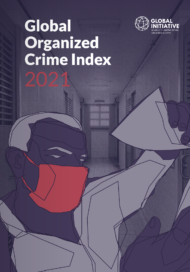Sustained by fear and fostered by distrust in often corrupt institutions, extortion hinders economic growth in northern Central America. Rebuilding trust between governments and the community, and strengthening security and justice institutions are crucial to counter this crime and nurturing economic development.
Extortion has become pervasive in Central America. Referred to, darkly, as ‘the rent’ in El Salvador, monthly payments extorted from businesses in the region have become an accepted part of doing business. Meeting the demands of the gangs that control their territory by paying the negotiated monthly instalments is seen as just that – a form of ‘rent’.
This form of criminal governance is sustained by continual threats. Should the payments not be met, businesses are only too aware of the consequences. The gangs and criminal groups will deploy violence to instil fear in victims and make sure the payments continue to flow. It begins with psychological violence, such as threats made over the phone, develops to more overt displays of violence (shooting at or burning business premises), and escalates to personal violence (beating up the owner or employees). It can, and does, go further: victims or family members are killed. The latter is the least desirable outcome for the gang bosses, as it means a lucrative source of ‘rent’, a potential annuity, is cut off. But a murder does serve to send out a resounding message to the rest of the community and, thus, ensures the extortion payments will continue in perpetuity.
A structural issue
Extortion and the violence it perpetuates are the result of structural problems found across Central America, such as corruption, impunity for criminals and a general citizen distrust of state security and justice institutions. Polls on security perceptions in the region between 2018 and 2019 revealed that 77% of Guatemalans did not report crimes to the police because they did not think they would help them. Meanwhile, two-thirds of Hondurans felt security strategies in their country were not efficient; and 55.4% of Salvadorans thought that the most pressing problems in their country were crime and violence. In 2020, 89% of homicides in Guatemala were left unresolved and, between 2013 and 2018, 90% of criminal cases in El Salvador were still pending.
Weak police forces, already challenged by personnel undercapacity and resource constraints, and overwhelmed justice institutions mean that a coordinated response to extortion is severely hampered. Even in cases when an arrest is made by the police, victims will face an additional layer of risk, as there are no protocols in place to protect them against retaliation from criminals. Speaking on condition of anonymity, one businessperson told the Global Initiative Against Transnational Organized Crime (GI-TOC) that, when he reported a case of extortion attempt to the police, the officer revealed a tattoo signalling his affiliation to the gang responsible. Another, who had opened a new shop in San Salvador, was forced to ask the authorities which gang he needed to pay ‘the rent’ to.
Extortion is so prevalent in the region that it has become, along with lack of economic opportunities, the most common cause cited by migrants for attempting to leave their home country and head for the United States. Not only have Central American countries had insufficient capacity to provide adequate employment, but extortion has limited their economic development. It is estimated that, in 2015, extortion payments amounted to 1.7% of El Salvador’s and 1% of Honduras’s gross domestic product.
The private sector suffers extensive losses from extortion; the public transport and delivery industries are among the worst affected. In 2018, Guatemalan companies paid some US$10 million in extortion fees and, in 2021, public transport companies in El Salvador paid US$12 million. The huge loss in revenue is often passed on to consumers in the form of rising prices and reduced wages. Extortion also creates aggressive competition among businesses. To avoid being extorted, businesses may leak information about their competitors to the gangs, forcing them out of business. Some even fake extortion payments to justify their deducting fees from their employees.
Investing in the future
Efforts to tackle these structural problems have recently been ramped up as migratory flows heading north across the Rio Grande have more than doubled in the last five years. This has led to international initiatives to better understand the extortion phenomenon and generate resilience to it, such as the GI-TOC’s research and analysis, and address underlying economic factors by implementing programmes and policies with local stakeholders. For example, President Joe Biden’s administration announced a project to bring economic investment to Central America and, in collaboration with Mexico, to create the programme Sembrando Oportunidades (sowing opportunities) for economic development in Guatemala, El Salvador and Honduras aimed at supporting at-risk and unemployed youth.
Initiatives such as these are all examples of regional efforts, but yielding economic results will be a long-term goal. Given the weak institutional response to extortion, controlling it – let alone reducing it – is still a daunting task in the short term. It will require strengthening the capacities of security and justice personnel to generate reliable data focusing on researching and investigating criminal groups and territories. It also means increasing the resilience of community members and businesses to create context-based solutions. Finally, it is crucial to strengthen trust between governments and citizens to generate responses to adapt to each context. Only then will businesses be able to escape extortion fees and citizens will not have to live in fear.
Sign up to the GI-TOC Observatory in Central America (CAM-Obs) mailing List
Alimentada por el miedo y sostenida por la desconfianza en autoridades a menudo corruptas, la extorsión obstaculiza el crecimiento económico del norte de Centroamérica. Es fundamental recuperar la confianza entre Gobierno y comunidad, y fortalecer las instituciones de seguridad y justicia para hacer frente a este crimen e impulsar el desarrollo económico.
La extorsión se ha convertido en un crimen generalizado en Centroamérica. En El Salvador, donde se le conoce como «renta», los comerciantes de la región dan por sentado los pagos mensuales que deben tramitar para cubrir las demandas de las pandillas que controlan su territorio. Es un hecho tan normalizado que algunas víctimas solo reconocen como «extorsión» aquellos pagos que se les solicita además de las cuotas mensuales.
Esta forma de gobernanza criminal se alimenta de amenazas por no cumplir los pagos, y las pandillas y otros grupos criminales utilizan una escala de violencia para infundir miedo en las víctimas. Se empieza con violencia psicológica (amenazas telefónicas), se pasa a la violencia patrimonial (balacera o incendio del comercio), se incrementa a violencia física (golpiza al propietario o a los empleados) y, finalmente, se recurre a la violencia letal (asesinato de la víctima o de un familiar). Este último es el desenlace menos deseable para las pandillas debido a que termina con la fuente de ingresos, pero refuerza la amenaza hacia el resto de la comunidad y, por tanto, asegura la recolección de los pagos por extorsión a largo plazo.
Un problema estructural
La extorsión y la violencia que esta genera son el resultado de problemas estructurales en Centroamérica como la corrupción, la impunidad y la desconfianza en las instituciones de seguridad y justicia. Entre 2018 y 2019, encuestas sobre percepción de seguridad en la región revelaron que un 77 % de guatemaltecos no denunciaron delitos ante la policía porque no creyeron que serían ayudados; un 65,7 % de hondureños sintieron que las estrategias de seguridad en su país no eran eficientes; y un 55,5 % de salvadoreños creyeron que los problemas más apremiantes en su país eran el crimen y la violencia. En el 2020, un 89 % de los homicidios en Guatemala quedaron sin resolver y, en El Salvador, un 90 % de los casos criminales registrados entre 2013 y 2018 siguen pendientes.
Fuerzas policiales carecientes de personal y recursos e instituciones de justicia saturadas obstaculizan las respuestas coordinadas frente a la extorsión. Incluso tras un arresto por parte de la policía, las víctimas se enfrentan a un nivel de riesgo adicional ante la falta de protocolos para protegerlas de represalias de la mano de los criminales. Bajo condición de anonimato, un comerciante relató a The Global Initiative Against Transnational Organized Crime (la iniciativa global contra el crimen organizado transnacional, GI-TOC) que, al denunciar un intento de extorsión ante las autoridades, el oficial le mostró un tatuaje que confirmaba su afiliación a la pandilla que lo estaba extorsionando. Otro comerciante que había abierto una tienda en San Salvador se vio forzado a preguntar a las autoridades a qué pandilla necesitaba pagar la «renta».
La extorsión es tan predominante en la región que se ha convertido, junto con la falta de oportunidades económicas, en la razón principal referida por los migrantes para tratar de llegar a Estados Unidos. Además de que la capacidad de proveer empleo adecuado es insuficiente en los países de Centroamérica, la extorsión ha limitado su desarrollo económico. Se estima que, en 2015, los pagos por extorsión ascendieron al 1,7 % y al 1 % del producto interno bruto de El Salvador y Honduras, respectivamente.
El sector privado es ampliamente extorsionado, y el transporte público y las compañías de reparto son los negocios más afectados. En 2018, las compañías guatemaltecas pagaron en total 10 millones de dólares americanos en cuotas por extorsión y, en 2021, compañías de transporte público en El Salvador pagaron 12 millones de dólares. Esta pérdida de ingresos se compensa con el aumento de las tarifas al consumidor y la reducción de los sueldos para desviar los costos de extorsión. Además, la extorsión genera competencia entre negocios: para evitar ser extorsionados, a menudo los comerciantes proporcionan información sobre sus competidores a pandillas y criminales, obligándolos a cerrar. Algunos incluso falsifican pagos de extorsión para justificar deducciones adicionales a los empleados y embolsarse el beneficio.
Invirtiendo en el futuro
Los esfuerzos para abordar estos problemas estructurales se han intensificado recientemente conforme los flujos migratorios con destino al Río Grande han crecido a más del doble en los últimos cinco años. Esto ha generado iniciativas internacionales para comprender mejor la extorsión y construir resiliencia frente a ella así como para abordar los factores económicos estructurales implementando programas y políticas públicas con actores locales; proyectos como la investigación y el análisis desarrollados por GI-TOC. Por ejemplo, en mayo del 2021, la administración del presidente de Estados Unidos Joe Biden anunció una iniciativa para impulsar las inversiones en Centroamérica y, en colaboración con México, creó el programa para el desarrollo económico en Guatemala, El Salvador y Honduras «Sembrando oportunidades», dirigido a jóvenes sin empleo y en situación de riesgo.
Proyectos como estos son ejemplos de iniciativas regionales, pero la obtención de resultados económicos será una meta a largo plazo. Dada la débil respuesta institucional frente a la extorsión, controlarla – por no hablar de reducirla – sigue siendo un objetivo difícil a corto plazo. Para lograrlo, se requiere fortalecer las capacidades del personal de seguridad y justicia y habilitarlos para generar información confiable sobre los grupos criminales y sus territorios. También requerirá fomentar la resiliencia de las comunidades y los comercios para crear soluciones basadas en contextos específicos. Finalmente, es crucial fortalecer la confianza entre los ciudadanos y los Gobiernos para generar respuestas comunitarias que se adapten a cada situación. Solo entonces podrán los comercios escapar de la extorsión y los ciudadanos no tendrán que vivir con miedo.
Sign up to the GI-TOC Observatory in Central America (CAM-Obs) mailing List



